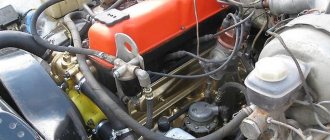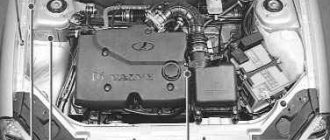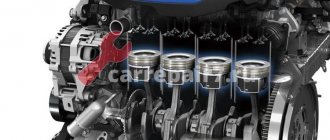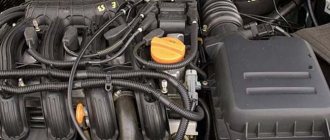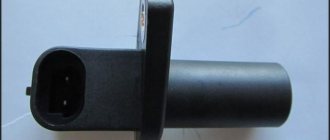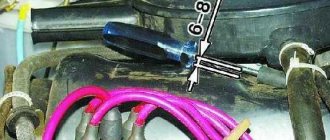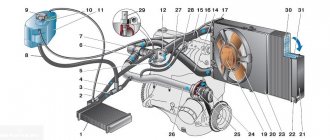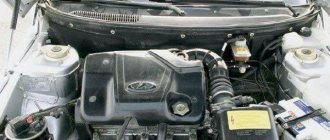Short description
The VAZ-2112 engine was installed on VAZ-2110, VAZ-2111 and VAZ-2112 cars. The engine was not created from scratch, the base was the 21083 engine. The engine retained the basic geometric dimensions of the 83rd engine, but at the same time it was radically different from it, both in terms of power and performance indicators. These and General Motors were involved in the development of the engine. In particular, together with General Motors, a distributed fuel injection system was developed. The engine turned out to be very economical. The main disadvantages of the engine are the lack of torque at low speeds (noticeable pick-up at 3500 rpm), unreliable belt drive and rollers, bending valves when the timing belt breaks
Weak spots
Unfortunately, the VAZ-2112 is not without them. The most important one is the timing belt. If it breaks, a meeting with the valves is inevitable. And this is already a serious repair of the cylinder head. A pump leak can cause a breakdown, causing the belt to become splashed with coolant, become wet and lose its properties.
Leaking camshaft oil seals cause the belt to become oily, which is no less dangerous. Wearing the shafts also does not bring any benefit. The fact is that in this case the belt gets slightly distorted. Its presence is indicated by the appearance of a grinding noise when the engine is not warmed up.
Sometimes the motor starts to “trouble”. As a rule, the cause of this phenomenon must be sought in the electrics (ignition module, high-voltage wires, spark plugs) or in the throttle valve, idle air control. The culprit may be various sensors (DPKV, DPS, DMRV).
The thermostat does not shine with quality. As a result of its failure, the engine may overheat, or, conversely, the inability to reach operating temperature.
The car owner is often bothered by various unauthorized noises. They are worth paying close attention to. Knocks can be caused by faulty hydraulic compensators, connecting rod or main bearings.
If any malfunctions are detected, the best solution would be to go to a service station to diagnose the engine.
Engine characteristics VAZ 2112 1.5 16V
| Parameter | Meaning |
| Configuration | L |
| Number of cylinders | 4 |
| Volume, l | 1,488 |
| Cylinder diameter, mm | 82 |
| Piston stroke, mm | 71 |
| Compression ratio | 10,5 |
| Number of valves per cylinder | 4 (2-inlet; 2-outlet) |
| Gas distribution mechanism | DOHC |
| Cylinder operating order | 1-3-4-2 |
| Rated engine power / at engine speed | 68.4 kW-(93 hp) / 5600 rpm |
| Maximum torque/at engine speed | 133.3 N•m / 3300 rpm |
| Supply system | distributed injection with electronic control |
| Recommended minimum octane number of gasoline | 95 |
| Environmental standards | Euro 3 |
| Weight, kg | 120 |
Engine tuning VAZ 2112 1.5 16V
Chip tuning of VAZ 2112 engine
The first thing that comes to the mind of a novice tuner is engine firmware; all companies promise that your engine will at least fly... all this is heresy. Firmwares give the most minimal effect, which is very difficult to feel; you have to think about chip tuning when the engine is with a turbine; aspirated engines are a waste of money. Since it is correct to boost the VAZ 2112 engine, with minimal loss of life and with a maximum increase in horses. The simplest and fairly standard way to increase the power of a VAZ 2112 engine is to replace the camshafts with STI-1 (for a standard receiver), STI-3.1, STI-2 or Stolnikov 8.9 (more expensive than others), to make life easier for the engine, we install a light ShPG from 126 engine, throttle body 54-56 mm, mounted receiver and exhaust 4-2-1. At the output we have about 120 hp. Refinement of the cylinder head and evil wide-phase shafts can increase power to 130-140 or more hp. To this it is worth adding a crankshaft with a stroke of 75.6 to increase the engine capacity of the VAZ 2112 to 1.6 liters, lightweight T-shaped valves, modification of the cylinder head and intake manifold, at the output we get about 140-150 hp. For the city, these indicators are enough for almost any car enthusiast.
Installing a compressor on a VAZ 2112
An alternative method of modifying the 2112 engine and obtaining similar power is to install a compressor. The well-known video clearly explains everything that is required for the successful implementation of the project using an eight-valve engine as an example; this compressor can also be installed on a 16-valve engine, the engine output will be more than 130 hp. You can use other compressors, but blowing more than 0.5 bar into a standard engine without reducing the compression ratio is risky.
Attention MAT (18+)
Throttle for VAZ 2112
To increase the stability of the engine and the response of the gas pedal, install 4 throttles. The bottom line is that each cylinder receives its own throttle valve and, thanks to this, resonant air vibrations between the cylinders disappear. We have more stable engine operation from bottom to top, plus this intake is shorter and air gets into the cylinders as quickly as possible. The most popular method is to install a 4-throttle intake from Toyota Levin on a VAZ. You need to purchase: the unit itself, make an adapter manifold and pipes, in addition to this you need a nulevik filter, injectors, MAP (absolute pressure sensor), fuel pressure regulator and firmware. There are also ready-made 4-throttle intake kits on sale that are quite suitable for use. It is recommended to install a light piston engine (from Priora, for example), because turning a heavy piston is an additional waste of energy, wide-phase shafts, for example STI-6 or STI-7 Touring Light, a modified cylinder head with light valves and solid pushers, Opel C20XE springs, spider exhaust 4-1 or 4-2-1 at 51, and better than a 63 pipe. With the correct configuration, the 2112 engine produces about 180-200 hp. To completely launch the car into space, at a volume of 1.5 liters, we install STI Sport-8 shafts. There is no point in writing a motor configuration for such shafts; very few people decide to assemble such a thing. The disadvantages include a reduction in engine life and this is not surprising, because the engines on the pipes spin at 8000-9000 or more rpm. So you cannot avoid constant breakdowns and frequent repairs of the 2112 engine.
Cylinder block
The 2112 cylinder block is made of high-strength cast iron, and at first glance, is similar to the 21083 block. The main differences are the diameter of the head mounting bolts and holes for them in the block reduced to 10 mm, lugs for the fuel injection system sensors and a completely different technology for honing the cylinders during production .
| Parameter | Meaning |
| Material | Ductile iron |
| Cylinder diameter, mm | 82,0 |
| Intercylinder distance (distance between the axes of adjacent cylinders of the block), mm | 89,0 |
| Block height (distance between the upper plane of the block and the axis of the crankshaft), mm | 194,80 |
| Diameter of boring of crankshaft supports (for main bearings), mm | 54,52 |
| Weight, kg | 28,810 |
For the VAZ 2112 block, five size groups are defined. Size classes are designated by letters: A, B, C, D, E.
Piston
On pistons 2112, the wells have a depth of 3.19 mm for the inlet and 3.06 mm for the exhaust.
| Parameter | Meaning |
| Diameter, mm | 82,0 |
| Compression height, mm | 37,9 |
| Volume of internal recess, ss | 0,638 |
| Weight, g | 350 |
The piston pin is steel, hollow, floating type. The outer diameter of the piston pin is 2112–22 mm, the length of the pin is 60.5 mm. The hole for the piston pin is shifted from the center plane of the piston by 1 mm.
Prices for VAZ 2110 2111 2112 21124 engines on the secondary market (2020)
VAZ 2112 21124 16 valve engines, characteristics, maintenance
In 1997, the VAZ 2112 saw the light of day - it was the first serial AvtoVAZ 16-valve engine with two camshafts. Its volume was the usual 1.5 liters, it produced 92 horsepower with 130 Nm of torque. It was first installed on the Lada 2110, but the following year, 1998, the Lada 2112 started with it, and in 2000 it was also installed on the Lada 2113.
The VAZ 2112 engine was used by the concern for about 7 years. In 2004, a new generation VAZ engine began to be installed on the Lada 2110 - VAZ 21124. Which became 100 mm larger, slightly more powerful and more environmentally friendly (the main difference from its predecessor was an improved catalytic converter and new, individual ignition coils). Now Lada cars with a VAZ 21214 engine passed Euro 3 environmental standards (after modifications to the catalytic converter, and Euro 4). The VAZ 21214 engine lasted on the assembly line almost twice as long as its predecessor - from 2004 to 2013 and was installed on: Lada 2110, Lada 2112, Lada 2111, Lada Samara hatchback, Lada Samara Coupe.
Characteristics of the VAZ 2112 engine:
| Table 1. Characteristics of the VAZ 2112 engine | |||
| Volume / Timing Drive | Power/Torque | Power system / Fuel type | Environmental standards |
| 1499 cm cube / Belt | 92 hp / 130 Nm | Injector / Gasoline AI-92 | EURO 2 |
| Table 1.1. Characteristics of the VAZ 2112 engine | |||
| Type / Number of cylinders / Valves | Cylinder diameter | Piston stroke | Compression ratio of the fuel mixture |
| Inline / 4 / 16 | 82 mm | 71 mm | 10.5 |
Installed on*: Lada 2110, Lada 2112, Lada 2113
- Oil maintenance every 10 - 15 t.km. mileage, every second maintenance - replacement of spark plugs and, if necessary, the air filter;
- Checking the serviceability of hydraulic compensators every 60 t.km;
- Every 45 t.km. — checking the condition of the thermostat, radiator fan, cooling system pipes;
- Every 90 t.km. — replacing the alternator belt and coolant;
- Replace the timing belt every 180 thousand km or every five years (whichever comes first).
Each maintenance checks the condition of the timing belt on a cold engine (plug-in engine);
VAZ 2112 car prototype
Characteristics of the VAZ 21124 engine:
| Table 2. Characteristics of the VAZ 21124 engine | |||
| Volume / Timing Drive | Power/Torque | Power system / Fuel type | Environmental standards |
| 1599 cm cube / Belt | 90 hp / 133 Nm | Injector / Gasoline AI-92 | EURO 3/4 |
| Table 2.1. Characteristics of the VAZ 21124 engine | |||
| Type / Number of cylinders / Valves | Cylinder diameter | Piston stroke | Compression ratio of the fuel mixture |
| Inline / 4 / 16 | 82 mm | 75.6 mm | 10.3 |
Installed on*: Lada 2110, Lada 2111, Lada 2112, Lada Samara hatchback, Lada Samara Coupe
- Oil maintenance every 10 - 15 t.km. mileage, every second maintenance - replacement of spark plugs and, if necessary, the air filter;
- When carrying out maintenance, it is advisable to check the condition of the timing belt (the engine is not “plug-in”, there are recesses for valves on the pistons);
- Checking the serviceability of hydraulic compensators every 60 t.km;
- Every 45 t.km. — checking the condition of the thermostat, radiator fan, cooling system pipes;
- Every 90 t.km. — replacing the alternator belt and coolant;
- Replace the timing belt every 180 thousand km or every five years (whichever comes first).
Engine modifications
Due to the presence of free space inside the block and cylinder head, immediately after the creation of the basic version of the two-shaft 16-valve engine 2112, its versions began to appear:
- 21124 – boosting the internal combustion engine to 89 hp. With. due to the volume of 1.6 l;
- 21126 – modernization of the engine to a power of 98 hp. pp., volume 1.6 l;
- 21128 – maximum combustion chamber volumes 1.8 liters, power increase to 105 liters. With.
In these versions, the valves do not bend; overhauls are needed much less frequently. The first version was created solely to increase volume and comply with Euro-3 standards. Factory tuning was carried out by increasing the block height to 197.1 mm and increasing the piston stroke.
In the second version, the designers tried to ensure the maximum operational life of the units. For this purpose, special cylinder honing is used using the Federal Mogul method. Block 21126 is gray in color, and the number of classes of repair kits for pistons and cylinder liners has been reduced to three in increments of 0.01 mm.
Version 21128 is not manufactured by AvtoVAZ, but by a third-party manufacturer, ZAO Super-Avto. Engine characteristics have been significantly improved:
- volume 1.8 l;
- torque 162 Nm;
- power 75 kW.
The cylinders are bored by 0.5 mm (diameter 82.5 mm), an original crankshaft has been developed that provides a piston stroke of 84 mm, the width of the rings has been changed to 2 mm (oil scraper), 1.5 mm (lower compression) and 1 mm (upper compression) . The throttle flow area has been increased to 51 mm, Siemens injectors with increased performance have been installed.
There are two more modifications of the ICE 2112:
- 21127 - created in 2013, torque increased to 148 Nm, volume to 1.6 liters, power to 106 hp. With.;
- 21179 is the first option in the manufacturer’s line with a volume of 1.8 liters for Largus and Vesta.
ICE 2127
ICE 21179
In the first version, the problem of floating speed is solved by replacing one MAF (mass air flow) with two sensors DTV (air temperature) and DBP (absolute pressure).
The 21179 motor used a phase shifter for the first time; it was created on the basis of the 21126, therefore it is conventionally considered a modernization of the 2112 generation.
Phase shifter 21179


